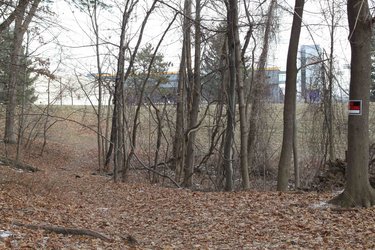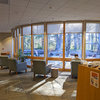What will happen to 9 acres between UAlbany and McKownville?
GUILDERLAND — The University at Albany Foundation recently announced its purchase — in what it claims is a “buy-and-hold strategy” — of a rare, undeveloped nearly nine-acre tract of land just over the Albany city line, in McKownville, adjacent to the university.
Reactions from neighbors have been mixed. There was some relief that the long-vacant property would finally be maintained, but there was also a good deal of apprehension about what the university’s intentions might be, and how much residents’ views would count, in deciding what to do with the land and the two houses on it.
The foundation had made an offer on the property the last time it was up for sale, in 2011. At that time, the asking price had been $1.4 million, and the foundation’s offer had been $400,000 and had never been seriously considered, said Richard McGinn, the chief financial officer and associate executive director for the foundation.
The foundation was not looking to buy in 2015 when it was approached by the sellers, McGinn said, but when the foundation learned that it would be able to purchase the property — which was in the early stages of foreclosure — for a total of $600,000 including $115,000 in back taxes due the town of Guilderland, it seized the opportunity.
On Friday, officials from the university and the foundation toured the property with new Guilderland Supervisor Peter Barber and with Don Reeb, head of the McKownville Improvement Association.
The property shows up on the tax map as two separate parcels, said McGinn: a 3,004-square-foot house at 100-200 Nicholas Lane, which dates from the 19th Century, and a 3,248-square-foot house at 18 Waverly Place.

Storied history
During the tour, McGinn and Reeb disagreed about the date of the Nicholas Lane home’s construction, with McGinn giving it as the 1890 listed on the sales verification form from the town, and Reeb asserting that it was built in the 1830s.
The property has a storied history. The two existing houses were built by John E. Holt-Harris, a judge who lived in the Waverly Place home and whose descendants sold the entire property to the university foundation.
Part of the parcel was home, earlier, to William F. Barnes, the Republican leader of the legendary “Barnes machine” that ran Albany County in the early 20th Century. Barnes built the Chapel House that stood at the top of the hill above the two existing houses and that was constructed in the same style. The structure that Barnes built was originally a hunting lodge, which he often used as his residence; it later became the university’s chapel house until it burned down in 1985.
The property also contains three other structures: a barn with a deteriorated loft that needed to be secured before workers could go in to clear out debris, a carport, and a simple covered area for storage or garbage, McGinn said. The property also contains several uncovered pits, ranging from a foot or so to about five feet deep, that may once have been used for drainage and that he said will need to be secured soon.
The combined acreage is 8.7 acres.
The tour showed participants that, while the homes are in significant disrepair, they do have architectural value, and they contain — particularly the Nicholas Lane home — a number of elements worth at least salvaging, including plank floors, leaded windows, stained-glass windows, and ornate stonework.
Next steps
In the short term, because of safety issues, McGinn told The Enterprise, the university foundation needs to ensure that the houses are secure. This may involve boarding up the windows, or putting fencing up around just the houses in such a way that emergency vehicles can still access them if needed, he said. Whatever method is chosen, he said, this would be done to prevent intrusion and injury.
Since closing on the property on Dec. 15, foundation officials have walked through the properties and had some debris and garbage cleared away to allow for asbestos testing. Asbestos was discovered in both houses. The immediate priority for the foundation, said McGinn, will be to get estimates of the cost of remediating the asbestos.
McGinn said that he has heard of rumors circulating among residents, that the university will start demolishing the buildings right away. But in fact, he said, “We’re not predisposed to demolition, until our fact-finding is complete. Even if we do head in that direction, we would have to get all the required permits; it wouldn’t be an immediate thing.”
The next step, he said, if the foundation were to proceed with demolition, would be to invite Guilderland Town Historian Alice Begley to look over the properties and determine what should be saved in the town archives. Next would be to invite in the Historic Albany Foundation to take whatever items it might wish to salvage. “But we can only do that once we have taken care of the asbestos,” McGinn said.
Residents raise concerns
On Monday night, the same university and foundation officials met with concerned area residents for a question-and-answer session.
The crowd of about 50 residents raised a number of concerns, including:
— A number of residents noted that, while the foundation is subject to local zoning regulations, the university is not, and asked how much public input will be taken into account if and when ownership is transferred to the university.
James R. Van Voorst, vice president for finance and administration at the university, said that if that the university sought to build something on the site, it would still need to undergo a State Environmental Quality Review process. It would have “conversations” with the town and with local residents all along, and make “little tweaks” to accommodate their concerns.
— Donald Csaposs, who is the town’s grant writer and who lives on Norwood Street, said that $598,000 — which he said was the current assessed value of the combined property — “just disappeared from Guilderland’s tax rolls.” (See Letters to the Editor in this edition.)
Csaposs said that the total amount of taxes, including school, town, and county, on the property would amount to about $25,000 per year. He asked if the foundation would consider paying that amount each year, “to make the town whole.” McGinn noted that the town had just received a payment for back taxes of $115,000 and said that the foundation is currently researching whether the property is tax-exempt or not.
— David Nardolillo, who said his father owns a property on Norwood Street, asked if the university would agree to “backstop” property values and predicted that, if the university were to create a parking lot on the site, it would greatly exacerbate the flooding that is already a problem for the area. In that case, he said, “You’re going to have a lot of basements in the area flooding.”
— Paul Engster of Waverly Place asked if the university might consider using the tract of land as a home for a university president — even though the university recently purchased a home for this use in Guilderland — because he thought this idea would be welcomed by area residents. Van Voorst said that since the university currently had no plans for the site, this idea, like any other, could be considered.
— Engster also asked whether, assuming that the university does build something on the site in the future, it could promise that access would be from the school’s perimeter road, and not from Norwood Street or Waverly Place. Van Voorst said that it would depend on the land use, but that access from the perimeter road would indeed “be easier.”
— Ellen Manning of Norwood Street asked the officials to consider leaving some buffer — “a lot of trees” — around the outside of the property, regardless of the use, to separate it from the surrounding residences. Van Voorst said that, when the university built the Liberty Terrace apartment-style housing complex, it actively sought local residents’ views, and put in a berm and rerouted the road in response to their concerns.
— Neighbors walk their dogs on a number of old golf-cart paths around the perimeter of the property, said one resident, asking if they will still be able to do that. McGinn answered that, because of safety and liability issues, the answer has to be no.
During the tour on Friday, when asked about the university’s plans for the site, Van Voorst said, “If we were to announce that we planned to build a dorm on the site, residents would immediately want to know: ‘What kind of building will it be? How many students? Which direction will it face?’ So it doesn’t make any sense to start talking about any possible uses until we have artist sketches, design concepts, and other tangible things to discuss.”
Asked then if the university were planning to build a dormitory on the Holt-Harris property, Van Voorst said no. “We aren’t planning anything,” he said. “It’s simply a buy-and-hold. We have no money in our capital fund right now for this property.”
A day after the question-and-answer session, Reeb sent out an email announcing that the McKownville Improvement Association will hold an “emergency neighborhood meeting” next week, to discuss “what to ask for, what to oppose, and how to influence” plans for the site.



